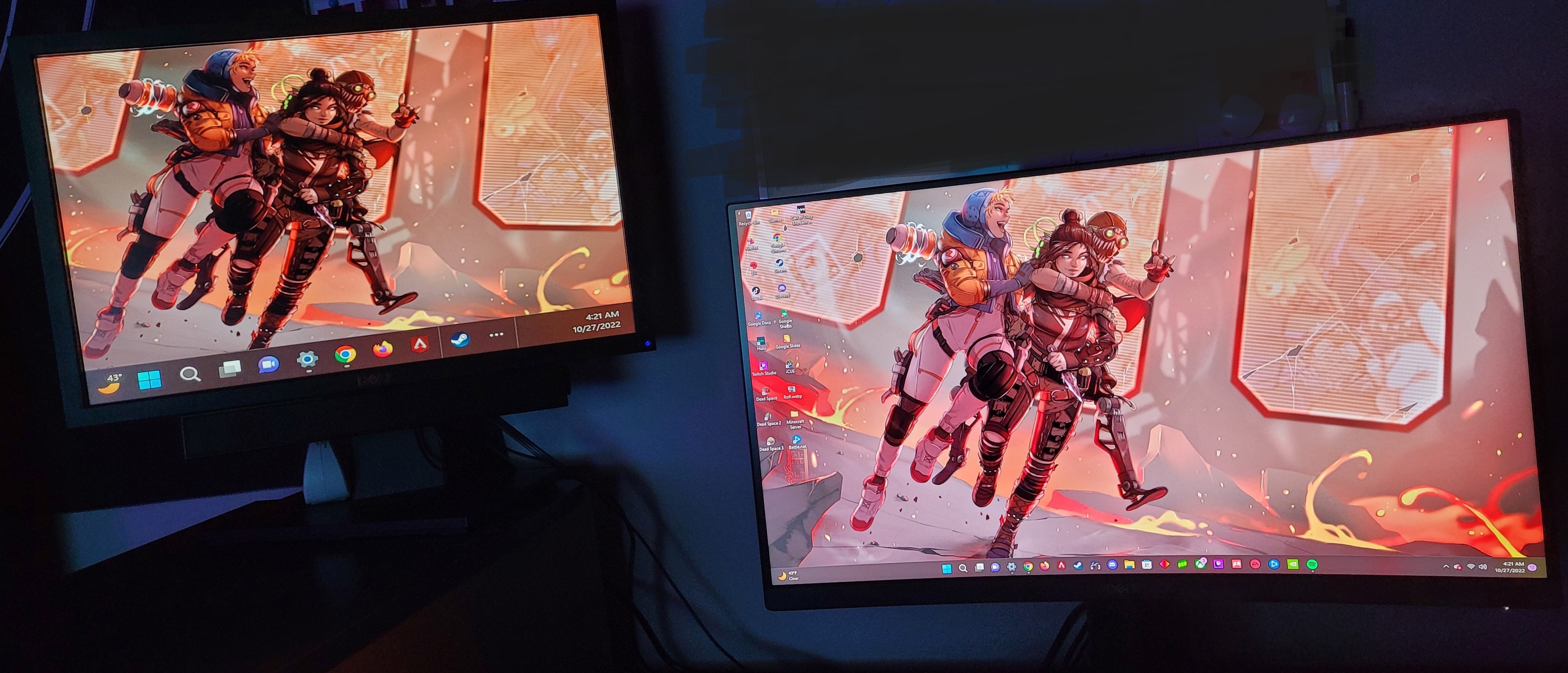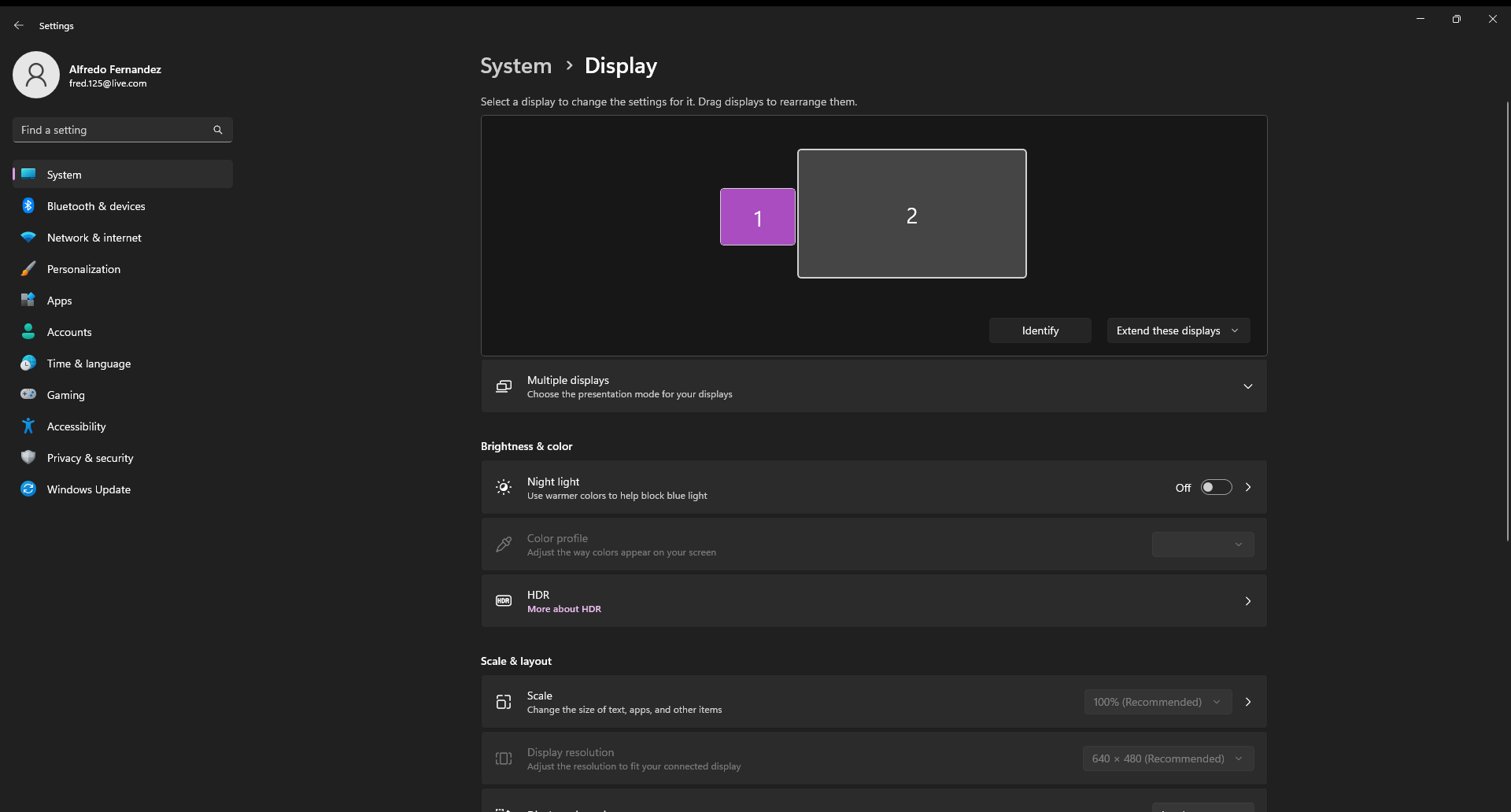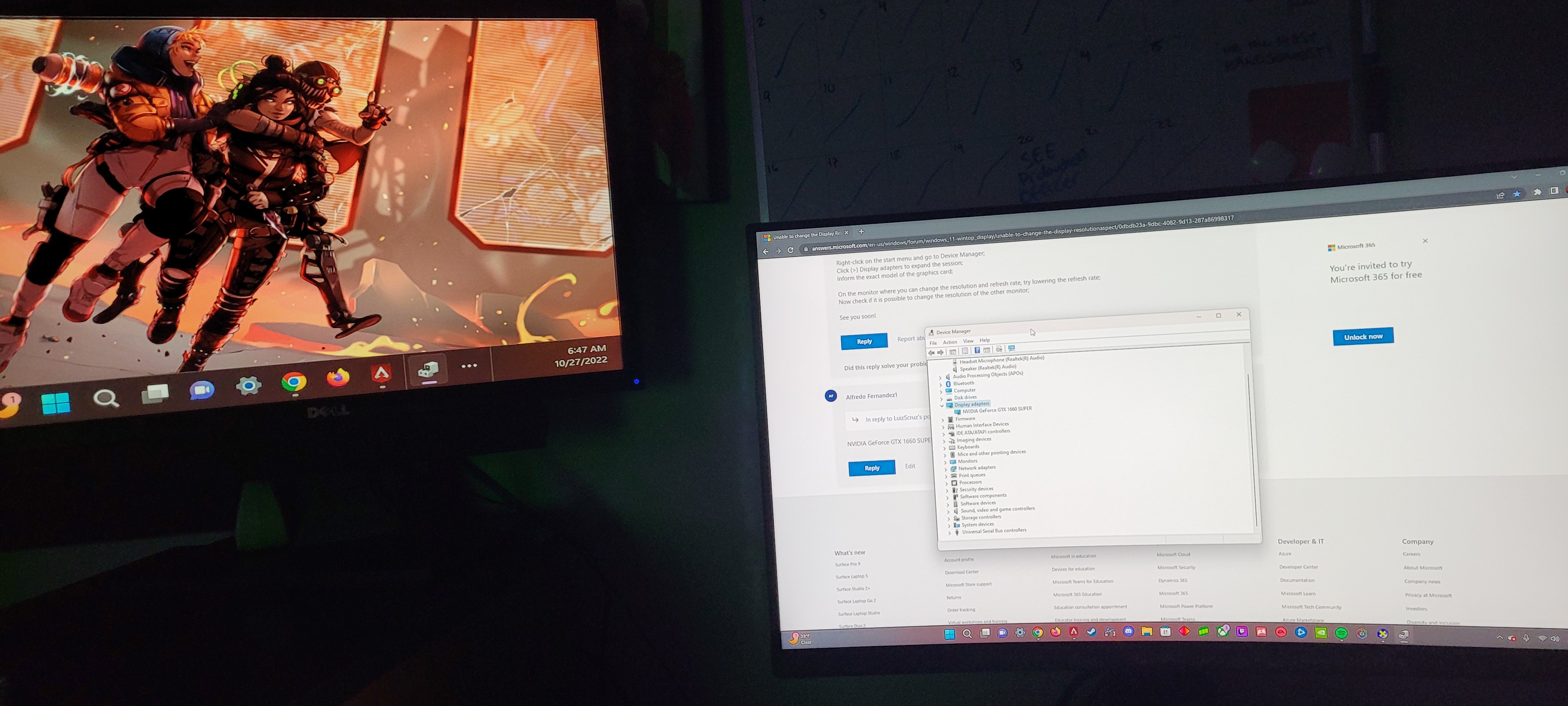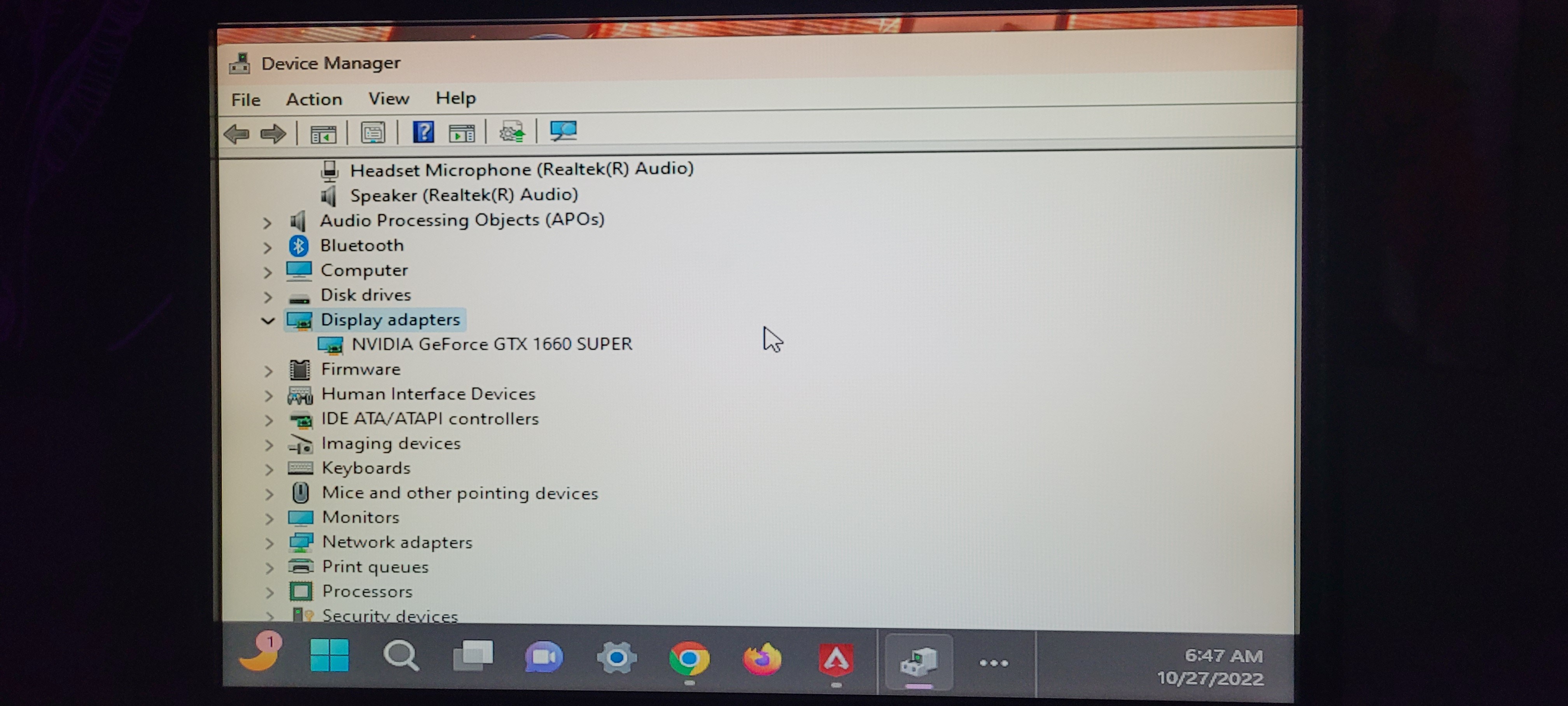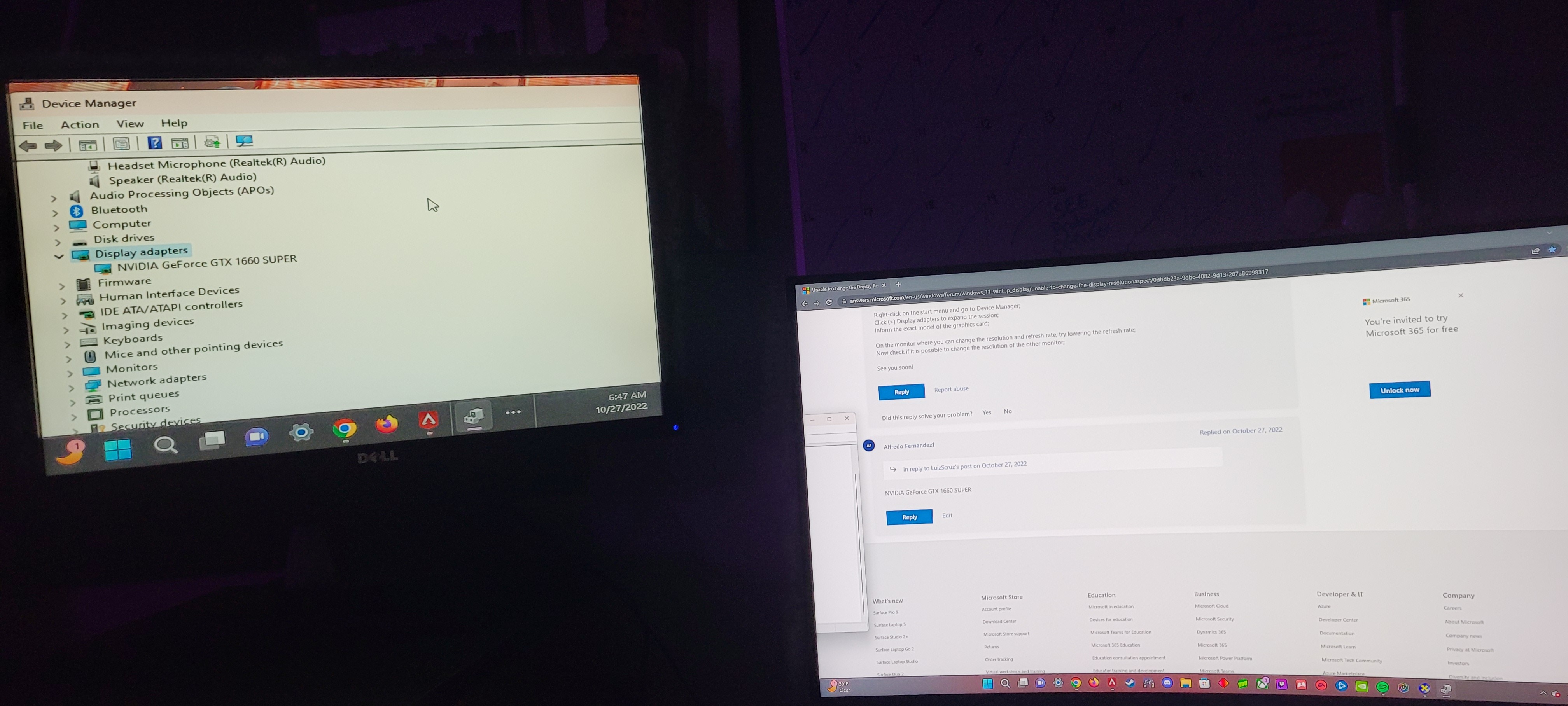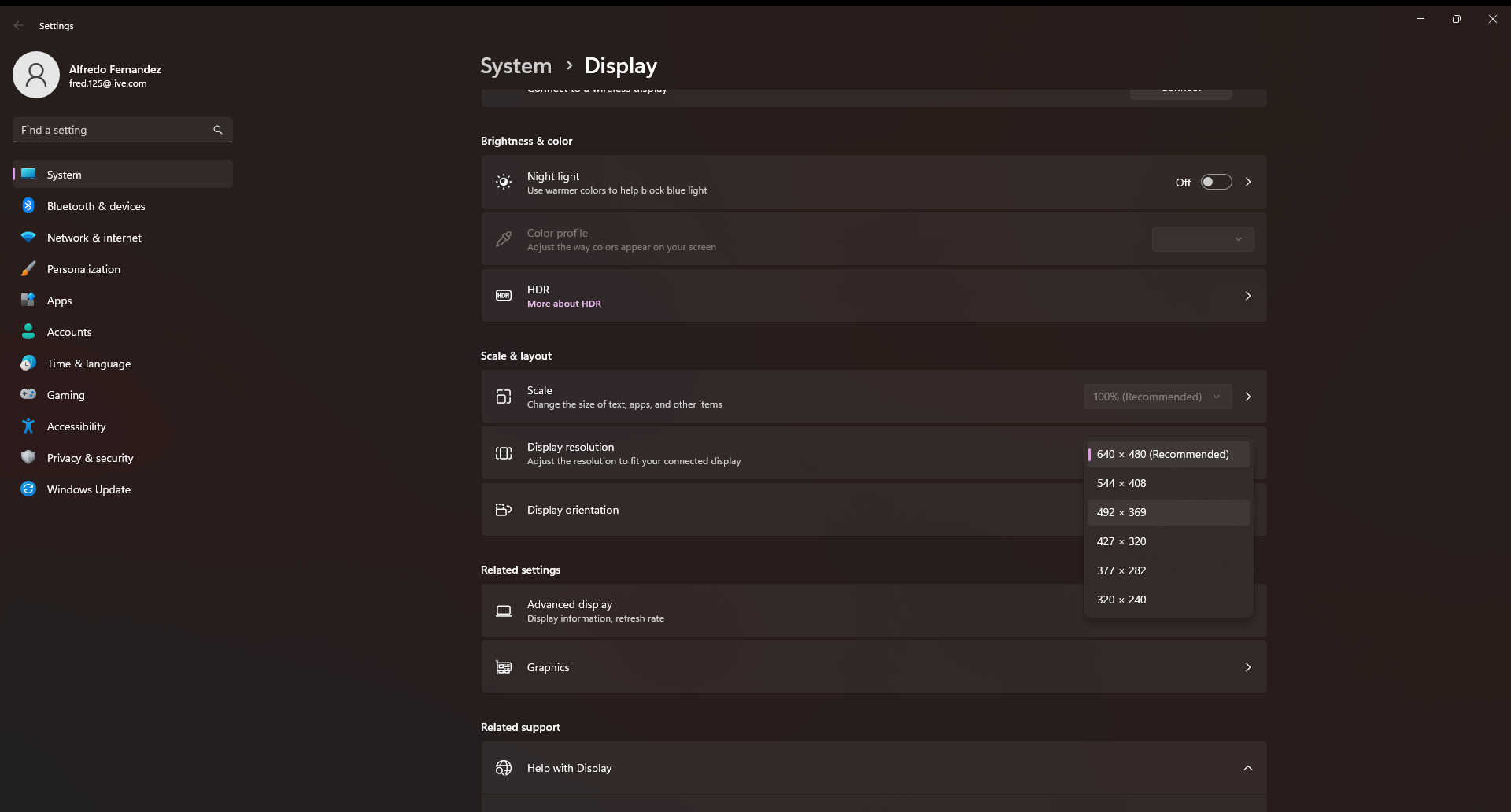I don't understand why my second monitor (left) looks like this? it says the display resolution is 640x480 but should be and WAS 1680x1050. It somehow just... changed.. and I've tried doing the same 5 things that every single link on google suggests - update driver. select a specific driver. uninstall driver. open device manager. use the command prompt. NONE OF THEM WORK. as you can clearly see the display resolution option is not allowing me to select any options (its greyed out.) selecting Display Adapter Properties in the Advanced Display page where it "Lists All Modes" only allows 640x480 with 60 hz refresh rate. every single youtube video and google link tell me the same exact 4 or 5 "solutions" and obviously they don't work. i dont understand why it changed and why it won't allow me to change it back.
November 12, 2024
Windows 11 Top Contributors:
Unable to change the Display Resolution/Aspect Ratio on 2nd monitor.
Report abuse
Thank you.
Reported content has been submitted
I understand that you are unable to change the resolution of the second monitor;
What exactly is the model and manufacturer of your graphics card?
Before answering the above question I suggest you try to decrease the monitor's refresh rate;
When lowering the refresh rate check if the resolution of the second monitor can be changed;
See you soon!
Report abuse
Thank you.
Reported content has been submitted
Was this reply helpful?
Sorry this didn't help.
Great! Thanks for your feedback.
How satisfied are you with this reply?
Thanks for your feedback, it helps us improve the site.
How satisfied are you with this reply?
Thanks for your feedback.
NVIDIA i guess? and on my first monitor (which is actually monitor #2) i can change the refresh rate and aspect ratio but i cant change anything on the 2nd monitor (which is actually monitor #1)
Report abuse
Thank you.
Reported content has been submitted
4 people found this reply helpful
·Was this reply helpful?
Sorry this didn't help.
Great! Thanks for your feedback.
How satisfied are you with this reply?
Thanks for your feedback, it helps us improve the site.
How satisfied are you with this reply?
Thanks for your feedback.
Right-click on the start menu and go to Device Manager;
Click (>) Display adapters to expand the session;
Inform the exact model of the graphics card;
On the monitor where you can change the resolution and refresh rate, try lowering the refresh rate;
Now check if it is possible to change the resolution of the other monitor;
See you soon!
Report abuse
Thank you.
Reported content has been submitted
Was this reply helpful?
Sorry this didn't help.
Great! Thanks for your feedback.
How satisfied are you with this reply?
Thanks for your feedback, it helps us improve the site.
How satisfied are you with this reply?
Thanks for your feedback.
NVIDIA GeForce GTX 1660 SUPER
Report abuse
Thank you.
Reported content has been submitted
Was this reply helpful?
Sorry this didn't help.
Great! Thanks for your feedback.
How satisfied are you with this reply?
Thanks for your feedback, it helps us improve the site.
How satisfied are you with this reply?
Thanks for your feedback.
i'd like to add that this is what applications look like on the 2nd monitor (monitor #1 in my Display settings - the monitor on the left in these photos) in comparison to how they should obviously look on my 1st/original monitor (monitor #2 in my Display settings - the monitor on the right)
Report abuse
Thank you.
Reported content has been submitted
1 person found this reply helpful
·Was this reply helpful?
Sorry this didn't help.
Great! Thanks for your feedback.
How satisfied are you with this reply?
Thanks for your feedback, it helps us improve the site.
How satisfied are you with this reply?
Thanks for your feedback.
Download and run the latest driver package for your video card:https://www.nvidia.com/Download/driverResults.a...
Follow the onscreen instructions until you get the Installation Options window;
Select the Custom (Advanced) box and press Next;
On the next screen, you will be able to choose the components to install (all should be checked by default and if you're not sure, leave them that way);
In the Select driver component table, check the Perform a clean installation box and click Next;
After clean installation of NVIDIA drivers, turn off the PC;
Disconnect both monitors from the PC;
First connect the monitor you want to be the main one and turn on the PC;
After login, connect the second monitor;
Now check if it is possible to change the resolution on the second monitor;
See you soon!
Report abuse
Thank you.
Reported content has been submitted
Was this reply helpful?
Sorry this didn't help.
Great! Thanks for your feedback.
How satisfied are you with this reply?
Thanks for your feedback, it helps us improve the site.
How satisfied are you with this reply?
Thanks for your feedback.
it worked for a day and now its back to the way it was before. i've tried re-doing what you suggested and it makes no difference. every time i plug in the second monitor it just connects automatically and doesn't allow me to configure anything. only difference is now instead of the Display Resolution options being greyed out it now lets me select from these options:
Report abuse
Thank you.
Reported content has been submitted
Was this reply helpful?
Sorry this didn't help.
Great! Thanks for your feedback.
How satisfied are you with this reply?
Thanks for your feedback, it helps us improve the site.
How satisfied are you with this reply?
Thanks for your feedback.
But don't worry, maybe another user in the community has a new solution;
See you soon!
Report abuse
Thank you.
Reported content has been submitted
Was this reply helpful?
Sorry this didn't help.
Great! Thanks for your feedback.
How satisfied are you with this reply?
Thanks for your feedback, it helps us improve the site.
How satisfied are you with this reply?
Thanks for your feedback.
1) Here's how to set different resolutions for each monitor in a multi-monitor setup:
https://www.addictivetips.com/windows-tips/diff...
2) But first The Display driver is so important here that merely updating it is sometimes not enough. So let's try everything possible to get it working correctly:
First make sure you have updated the Display driver from the PC or motherboard maker's Support Downloads web page for your exact model number, HP Serial Number or Dell Service Tag - from the sticker on the PC.
If necessary first remove the old driver using DDU https://www.wagnardsoft.com/content/ddu-guide-t... (not necessary with Microsoft Basic driver which is a placeholder if nothing else is available) and/or installing in Safe Mode with Networking (so you have internet), or Safe Mode, accessed by one of these methods: https://www.digitalcitizen.life/4-ways-boot-saf...
While there check also for newer chipset, BIOS/UEFI firmware (very important), network, sound, USB3 and other drivers, comparing to the ones presently installed in Device Manager reached by right clicking the Start Menu.
If this doesn't give you the latest or ideal driver for what you need, compare it to the driver offered by the Intel driver update Utility here: http://www.intel.com/content/www/us/en/support/...
or the Nvidia Update utility here: http://www.nvidia.com/Download/Scan.aspx?lang=e...
or the AMD autodect utility here: http://support.amd.com/us/gpudownload/windows/P...
For Display issues one fix that is working is to Roll back or Uninstall the Driver on the Display Device > Driver tab, restart PC to reinstall driver.
You can also try older drivers in Device Manager > Display device > Driver tab > Update Driver > Browse > Let Me Pick.
Then you will know you've tried everything in addition to Windows Update drivers.
Adjust the screen resolution until it fits and looks best at Settings > System > Display.
Check for a monitor driver by expediting Windows Updates (including Optional Updates) in Settings > Update & Security > Windows Update > Check for Updates to install all Updates until no more are offered.
Report back results for each step so I know what else to suggest.
Feel free to ask back any questions. Based on the results you post back I may have other suggestions if necessary.
______________________________________________
Standard Disclaimer: There are links to non-Microsoft websites. The pages appear to be providing accurate, safe information. Watch out for ads on the sites that may advertise products frequently classified as a PUP (Potentially Unwanted Products). Thoroughly research any product advertised on the sites before you decide to download and install it.
Retired 2023, thirteen year daily forums volunteer, Windows MVP 2010-2020
Report abuse
Thank you.
Reported content has been submitted
1 person found this reply helpful
·Was this reply helpful?
Sorry this didn't help.
Great! Thanks for your feedback.
How satisfied are you with this reply?
Thanks for your feedback, it helps us improve the site.
How satisfied are you with this reply?
Thanks for your feedback.
Question Info
Last updated November 13, 2024 Views 26,529 Applies to:

